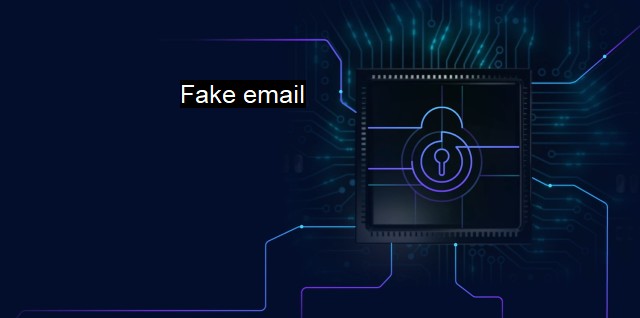What is Fake email?
The Emerging Risk of Fake-Emails: Analyzing their Impact on Cybersecurity and the Importance of Antivirus Software in their Mitigation
In the vast virtual universe of cyberspace, cybersecurity and antivirus software play a massive role in protecting users from a myriad of threats or attacks. One common cybersecurity issue that has attracted attention due to its rapid proliferation is the use of "fake emails." A fake email is essentially an unauthentic email sent from a forged or impersonated email address. Most often, these are malicious tactics employed by cybercriminals to deceive unsuspecting individuals or organizations and acquire their personal or financial data illegally.Fake emails, also categorised under "phishing attacks," often look like they have been sent by a legitimate organization or a known individual, thereby tricking recipients into believing in their authenticity. These emails can imitate banks, postal companies, tax agencies, e-commerce websites, social media platforms, or even personal acquaintances. the primary intent behind these emails is to steal the recipient's sensitive information or infect their systems with viruses or malware.
Cybercriminals design these bogus emails meticulously to appear genuine. They include logos, use a language style similar to the organization or the person they are mimicking, and may ask recipients to urgently verify their credentials or update their financial details, indicating severe consequences if overlooked.
More sophisticated fake emails can redirect victims to fake websites, identical copies of legitimate websites, via enclosed links. These websites capture the victims' information when they attempt to log in or enter their details, unknowingly handing over their valuable data directly to the cybercriminals.
To add another layer of deception, some fake emails come with malicious attachments disguised as important documents, like bills, invoices, or policy documents. Once downloaded or opened, these attachments execute malware, trojans, or ransomware on the victims' computers, giving fraudsters full control over their systems.
Fake emails can have a devastating impact on both individuals and companies. On a personal level, such attacks can lead to identity theft, substantial financial losses, and serious privacy breaches. As for businesses, falling for fake emails can result in the leakage of confidential corporate data, disruptions in operations, significant financial losses, reputational damage, and potential legal ramifications due to compliance violations.
Preventing the damage caused by fake emails primarily relies on increased awareness about such practices and appropriate cybersecurity measures. Internet users should be educated about recognising suspicious emails and the potential threats they pose. Checking the sender's email address for oddities, avoiding clicking on unknown links, not downloading unexpected attachments, and independently verifying any doubtful emails via other communication methods can help thwart such threats.
Robust cybersecurity and antivirus solutions are vital to counter fake emails. Advanced email filters can detect and redirect scam emails to spam or junk folders. Similarly, updated malware and antivirus software can protect against malicious downloads. Browsers with enhanced security features can alert users when they're being redirected to suspicious websites, thereby preventing potential phishing attempts.
In the cybersecurity landscape, staying one step ahead of cybercriminals remains crucial, as technology continues to evolve and innovative ways of cyberattacks are being formulated. Thus, regular updates of security software, awareness programs, stringent digital hygiene practices, and strong, unique passwords should also be part of an all-encompassing defense strategy against fake emails.
"fake emails" pose a real and persistent threat in today's digitized environment. They are manipulative strategies used by cyber attackers to instil fear, create a false sense of urgency, or present deceivingly innocent requests to capture private information or spread malicious software. Therefore, continuous vigilance, regular user education, and a robust cybersecurity infrastructure are essential to recognize and mitigate the risks associated with fake emails.

Fake email FAQs
What is a fake email?
A fake email is an email that appears to be legitimate but is actually a scam that attempts to steal your personal information or infect your computer with malware.How can I identify a fake email?
You can identify a fake email by checking the sender’s email address, looking for poor grammar or spelling mistakes in the body of the email, and being suspicious of urgent requests for personal or financial information.What are the risks of opening a fake email?
Opening a fake email can put your personal information at risk, such as your login credentials, social security number, and credit card details. Additionally, some fake emails contain links or attachments that can infect your computer with malware.How can I protect myself from fake emails?
To protect yourself from fake emails, be cautious when opening emails from unknown senders, avoid clicking on links or downloading attachments that you are not expecting, and use reliable antivirus software that can detect and block malicious emails. Additionally, always verify the legitimacy of requests for personal or financial information before providing any sensitive data.| | A | | | B | | | C | | | D | | | E | | | F | | | G | | | H | | | I | | | J | | | K | | | L | | | M | |
| | N | | | O | | | P | | | Q | | | R | | | S | | | T | | | U | | | V | | | W | | | X | | | Y | | | Z | |
| | 1 | | | 2 | | | 3 | | | 4 | | | 7 | | | 8 | | |||||||